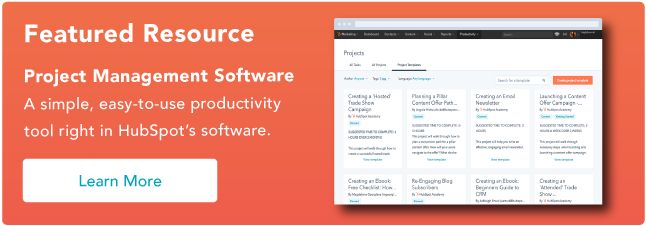The Complete Guide to Stakeholder Management
Successful projects have support from stakeholders across the organization. That’s why stakeholder management is essential for any initiative.

Successful projects have support from stakeholders across the organization. That’s why stakeholder management is essential for any initiative. Stakeholder management allows you to identify and meet leaders’ needs while keeping communication open. In this article, you’ll learn what stakeholder management is, why it's important, and how to create a stakeholder management plan. Table of Contents Stakeholder management is the process of identifying, assessing, and managing the interests and needs of stakeholders. An effective stakeholder management strategy should be backed by data and paint a clear picture of everyone involved. Projects fail when the interests and needs of stakeholders are ignored. This leads to a lack of buy-in from key stakeholders, which can jeopardize the success of the project. When stakeholders feel their needs are being met, they're more likely to support the project. On the other hand, if their needs are not met, they may try to block your initiative. Stakeholder management helps build positive relationships that keep your project running smoothly. An effective stakeholder management strategy can help you: There are many benefits of an effective stakeholder management strategy, including: While stakeholder management may seem intuitive for some, you can start building trust systematically with a more formal roadmap. The following six steps can help you understand stakeholder priorities and how you can address these needs. Stary by identifying all the individuals and groups who can impact your project, both positively and negatively. This includes internal stakeholders (such as team members) and external stakeholders (such as customers or suppliers). To identify your stakeholders, ask yourself the following questions. After you've identified all your stakeholders, the next step is prioritization. This will help you focus your attention on the stakeholders most important to your project's success. You should identify where their expectations lie, their level of influence, what information they will want from you, and how often they want reporting from your team. You can use stakeholder mapping to help you prioritize key leaders. The above stakeholder mapping exercise asks you to plot leaders on a two-by-two grid. One axis is labeled power and the other interest. On the power axis, you rate each stakeholder on their ability to influence the project. On the interest axis, you rate each stakeholder on their level of interest in the project. This will give you a clear picture of which stakeholders are the most important to engage with and how best to do so. There are several different ways to map stakeholders, including: The key to a successful stakeholder management plan is understanding your stakeholders. This will help you assess what they want from the project and how best to engage with them. At this stage, ask yourself the following questions. By understanding the answers to these questions, you can better develop a stakeholder management plan that fits each leader. Once you've identified and assessed your stakeholders, you can begin to define their motives. This will help you understand what they want from the project and how best to engage with them. There are several ways you can define stakeholder motives, including: By understanding stakeholder motives, you can develop an effective stakeholder management plan that meets their needs and interests. The goal of stakeholder engagement is to manage expectations and build relationships. This can be done through several different methods, including: The best way to engage with various leaders will depend on the stakeholder and the project. You should tailor your engagement plan to each individual. After you’ve identified stakeholders, it’s time to develop management plans for each group. The below templates can help you create engagement plans and organize your stakeholder communication. If you’re new to stakeholder management, this template from Asana offers a simple way to stay organized. In this plan, you write down each stakeholder, their level of interest in your project, and how influential they are to your work. Then, you can check a box to identify their communication preferences. That includes how often they want to hear from your team and how they want you to get in touch. What we love: With this template, you know which of your leaders prefer a quick Slack versus a formal email at a glance. If you’re looking for a more detailed engagement plan, consider this option from Project Management Docs. With this document, you can fully lay out the vision of your project and which departments your initiative will affect. What we love: This template includes charts and tables that you can use to determine each stakeholder's level of importance to your project. You can use this document to brainstorm and outline your final draft. If you’re looking for a complete guide to writing an engagement plan, KnowledgeHut is here to help. This template includes sections that help you identify stakeholders and create a timeline for each person’s involvement. You can also keep track of costs and human resources involvement. What we love: This template features charts that you can fill out with stakeholder data. If you get stuck, each section comes with helpful questions for self-reflection to guide you along the way. If you’ve been searching for a simple spreadsheet to manage your stakeholders, look no further. This template from PMTraining offers a straightforward approach to managing stakeholders. What we love: This template lays out who is involved, what they need to do for your project, and how you plan to keep them engaged. If you’re looking for a quick way to develop a one-page stakeholder management guide, this is it. Plus, everything can be edited in Google Docs. Formalizing stakeholder management can feel like an overwhelming process. Whether you’re just getting started or have years of experience, the following tips can help you ensure successful stakeholder management. According to PMI, 44% of projects fail because of a lack of alignment between business and project objectives. Before you begin engaging with stakeholders, it is crucial to define the purpose of the project. This will help you identify who you need to engage with and their objectives. At the start of a project, clearly define each stakeholder's roles and responsibilities. This will help ensure that everyone is clear on their involvement in the project. Regular communication is essential for successful stakeholder management. You should update stakeholders on the project regularly and solicit their feedback. Your strategic objectives should always be clear in stakeholder communication. This allows your team to manage stakeholder expectations and create positive relationships. It is important to be transparent with stakeholders about the project. This will help build trust and ensure everyone is on the same page. Feedback is essential for successful stakeholder management. You should seek feedback from stakeholders at every stage of the project. Keep track of their suggestions and implement their insights. You can then report back on how you implemented their solutions to further gain their support. Today, only one in four teams uses a project management software. Implementing one of these tools can help you keep organized. That ranges from project management software, like Basecamp or Asana, to collaboration software, like Google Drive or Trello. Choose a tech stack that best fits the needs of your project. Stakeholder management is not a one-size-fits-all process. You should be flexible and tailor your approach to each individual you work with. Stakeholders hold the power to influence your project, so engaging leaders while keeping their needs at the forefront will help keep things running smoothly. Keep these tips in mind as you develop your stakeholder management strategy to stay on track.
What is stakeholder management?
Why is stakeholder management important?
Benefits of Stakeholder Management
Inside the Stakeholder Management Process
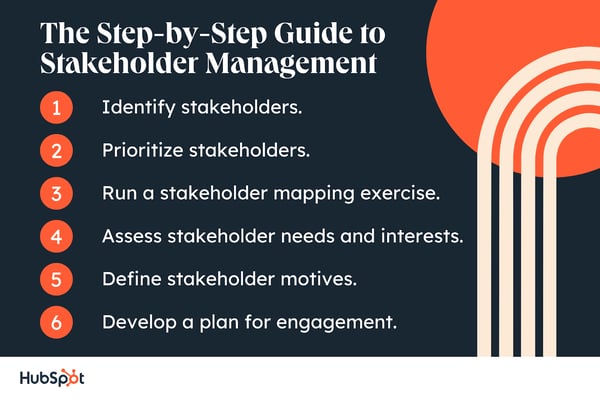
1. Identify stakeholders.
2. Prioritize stakeholders.
Run a Stakeholder Mapping Exercise
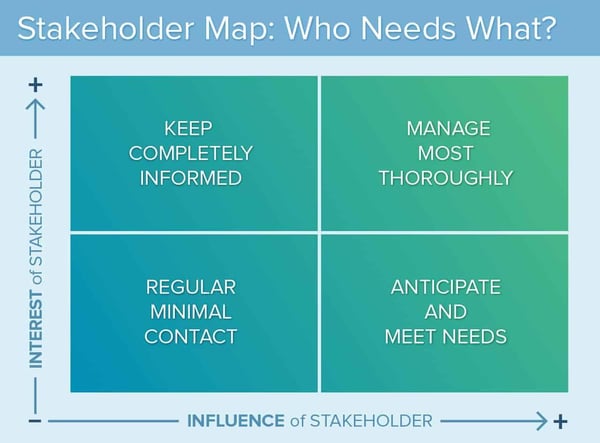
3. Assess stakeholder needs and interests.
4. Define stakeholder motives.
5. Develop a plan for engagement.
Stakeholder Management Plan Templates
Asana
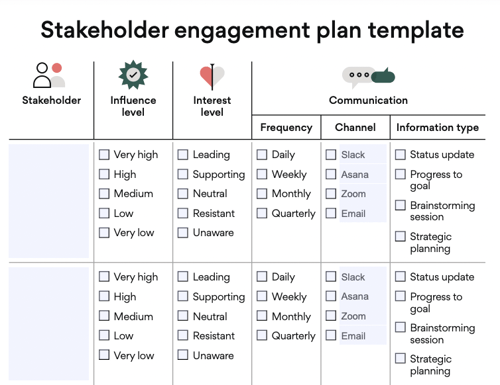
Project Management Docs
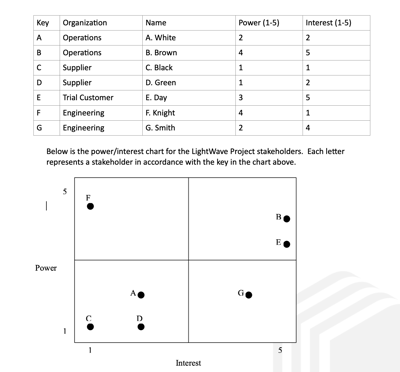
KnowledgeHut
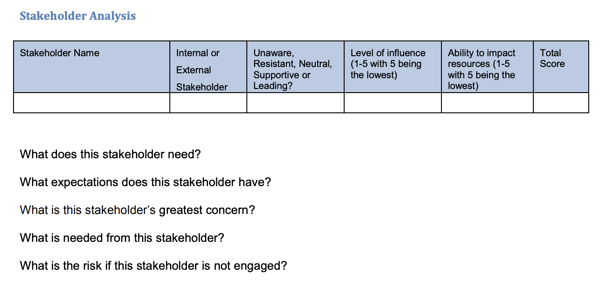
PM-Training
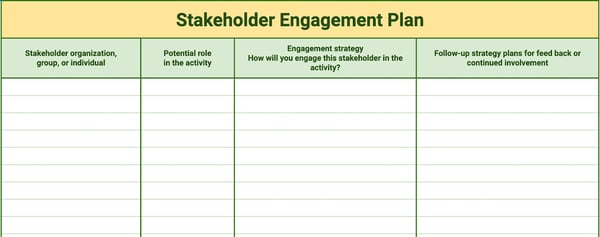
Tips for Stakeholder Management
1. Define the purpose of the project.
2. Define roles and responsibilities.
3. Communicate regularly.
4. Be transparent.
5. Seek feedback.
6. Choose the right software.
7. Be flexible.
Create an Effective Stakeholder Management Plan

 Konoly
Konoly 
